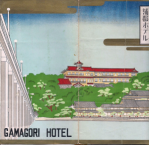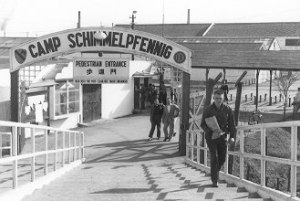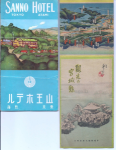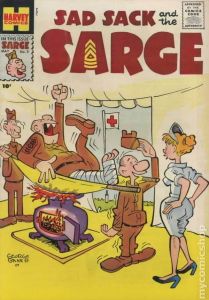Blog Archives
The Occupation Olympiad
While some of the troopers continued to await the arrival of the good ole’ American jeeps to replace the coal-burning vehicles in Japan, General Swing was striving to make the occupation as bearable as possible. They had endured some horrendous hardships and accomplished more than anyone expected from them and he felt they deserved whatever he could provide. On his orders, a Japanese auditorium was transformed into the 11th Airborne Coliseum. The complex was large enough to hold a theater that would seat 2,500, four basketball courts, a poolroom with 100 tables, a boxing arena that held 4,000 spectators, six bowling alleys and a training room.
Aside from the sports theme, the coliseum contained a Special Services office, a snack bar, a Red Cross office and a library. I can just picture my father spending some off-duty time in the poolroom or bowling alley. When I was growing up, we had a pool table in the basement and Smitty would teach me how every shot was related to angles and geometry. My aim improved – once I figured it out.
In the fall of 1945, an Olympiad was held in Tokyo for all the troops stationed in Japan and Korea. Football became the highlighted game. The 11th A/B Division coach, Lt. Eugene Bruce brought them to winning the Japan-Korea championship. They then went on to take the Hawaiian All-Stars in Mejii Stadium with a score of 18-0. This meant that the 11th Airborne Division held the All-Pacific Championship. The troopers went on to win in so many other sports that by the time the finals were held for the boxing tournament at Sendai, the headlines read in the Stars and Stripes sports section:
Ho-Hum, It’s the Angels Again”
On the reverse side of the photo seen above, Smitty wrote, “This is the hotel where we are now staying. That dot in the driveway is me.” The 11th A/B commander had made his home here on 16 September. After the occupation, it re-opened for business as a hotel, but unfortunately was destroyed by fire on 2 March 1969.
The division had a reputation for mission accomplishment despite being nearly half the size of other divisions. This was often attributed to their somewhat unorthodox methods. This carried over into their occupation of Japan. General Swing converted an old Japanese factory and had it turning out American-style furniture for the troops. General Headquarters wasn’t very happy about the project because they wanted the Japanese to build furniture for the entire command. But Swing was not one to wait for all the red tape. After General Eichelberger inspected the better-than-GHQ- standard brick barracks under construction, he said to Swing, “Joe, I don’t know whether to court-martial you or commend you.” (Later on, he was commending Swing.)
CLICK ON IMAGES TO ENLARGE.
##############################################################################################
Military Humor –
###############################################################################################
Farewell Salutes –
Albert D. Accurzio – Utica, NY; US Army Air Corps, WWII, PTO, Co A/675 Artillery/11th Airborne Division
George H. Anderson – Brockton, MA; US Army, WWII
Carroll Bierbower – Los Angeles, CA; US Navy, WWII, USS Comfort, hospital ship
Harding Bossier (102) – Baton Rouge, LA; US Army, WWII, PTO, Signal Corps
Harold E. Conant – Wyandotte, MI; US Merchant Marine / US Army Air Corps, WWII, (Ret. 20 y.)
Jack E. Dutton – Gardena, CA; US Army, Vietnam, Pfc.
Kenneth Fuller – Bacolod City, P.I.; US Army Air Corps, WWII, PTO, 511/11th Airborne Division, MP
Jane Hansen (101) – Portersville, PA; US Army Air Corps WAC, WWII, dietitian
Adeline Ney – Wilkes-Barre, PA; Civilian, WWII, ammo production
Frank C. Roop – Fairfax, TX; US Army, WWII, ETO, tank gunner
Ida (Mitchell) Wongrey – Nova Scotia, CAN; Canadian Civilian Navy Intelligence
#################################################################################################
MOVIN’ ON for the 11th AIRBORNE
This photograph was signed by two of my father’s buddies, John S. Lodero and Phil Martorano, both of Brooklyn, New York. Smitty (Everett Smith) circled, but which two men are John and Phil is unknown.
When the SCAP Headquarters was set up in Tokyo, MacArthur was determined to create a “Peaceful and responsible government…” He also had to administer to a nation with nearly 70 million near-starving civilians and a constantly growing population of soldiers. The Japanese made the transition of being under one totalitarian rule to another quite easily and the general proceeded to supervise the writing and implementation of a new constitution. This was adopted in 1947, retaining the Emperor as a constitutional monarch and reestablished the primacy of the Diet. The zaibatu industrial combines were broken up and women were given rights.
The 11th Airborne was amazed by the change of attitude of the populace; without ever having actually been invaded, the Americans were being accepted. It made their future missions so much easier to accomplish. The Americal Division relieved the 11th Airborne on 14 September at their present locations and the following day, they began moving out by truck and railroad to their newly assigned zones in northern Honshu. Gen. Swing requested Gen. Dorn, who had served with Gen. Stilwell in China, to head the convoy.
In the Sendai area and billeted at the Japanese arsenal [name to be changed to Camp Schimmelpfennig, [named after the chief of staff who was killed in combat] were the – Division Headquarters, 127th Engineers, 408th Quartermaster, 711th Ordnance, 511th Signal, 221st Medical, Parachute Maintenance and the 187th and 188th regiments. The 511th went to Morioka [ name would be changed to Camp Haugen, for their leader killed in combat], the 457th and the 152d moved to Akita, the 472d went to Yamagata, the 674th was divided and sent to Jimmachi and Camp Younghans and the 675th went to Yonezawa.
In the Sendai area, Japanese authorities turned over hotels in the Matsushima area for officer’s quarters and their staff, which explains how Smitty came home with these beautiful brochures you will see pictured here. If you click on and enlarge the photo, you can see where Smitty pointed to the sort of room he was given.
At one point while moving supplies, Eli Bernheim (S-4 Section of the 187th reg.), remembered the convoy of 40 Japanese charcoal burning trucks always breaking down and they became lost. The interpreter and Eli took out their map and became surrounded by curious townspeople. Eli slung his rifle over his shoulder and they scattered. The interpreter suggested laying the weapon down, the civilians regrouped and began touching his hair – turns out they had never seen an American before.
I suppose the word must have spread, because after that incident, the convoy was warmly greeted in every town they passed through. Once in their respective areas, the first priority was living conditions and the Japanese barracks were primitive with ancient plumbing and sewage deposited in reservoirs to be picked up later by farmers and used as fertilizer. The division historian recorded that of all the traffic accidents within the 11th A/B’s zone, NO trooper was ever guilty of hitting one of those “honey carts.”

General Swing made General Pierson commander of the 187th and 188th joint group which became known as the Miyagi Task Force. They set up their headquarters in an insurance company building in Sendai. The principle responsibility of the Miyagi Task Force was to collect and destroy all arms, munitions and armament factories. They were also charged with seeing that General MacArthur’s edicts were all carried out. Many of the military installations had underground tunnels filled with drill presses and machine tools of all types. The entire zone needed to be demilitarized and equipment destroyed. Colonel Tipton discovered a submarine base for the two-man subs and a small group of men still guarding them. They told the colonel that they just wanted to go home.
Inside this brochure my father wrote, “No liquor here so didn’t have to go behind the bar, we drank our own. This is where I had my first real hot bath since coming overseas.”
##############################################################################################
Military Humor – 
##########################################################################################
Farewell Salutes –
Burt Bacharach – Kew Gardens, MO; US Army, / composer, musician, producer
Emett “Ole Sam” Brown – Spirit Lake, ID, US Navy, WWII
Donald Cherrie – Nanticoke, PA; US Army, WWII
Donald L. Dupont – WI; US Army, Korea, Cpl., B Co/1/32/7th Infantry Division, KIA (Chosin Reservoir, NK)
Morton L. Gubin – Mount Vernon, NY; US Navy, WWII, PTO, LCT command
Julia LaFlamme – Gardner, MA; US Army WAC, WWII, aircraft mechanic, Windsor Locks Army Air Base
Vivian Nostrand – Kearny, NJ; US Navy WAVES, WWII, Aerographer’s mate
Robert Reynolds – Pasadena, CA; US Army, 11th Airborne Division
Rand K. Shotwell – Dallas, TX; US Army, Vietnam, 173rd Airborne, 3-Bronze Stars, West Point class of ’67
George W. Winger – Chicago, IL; US Army Air Corps, WWII, ETO, 1st Lt., 66BS/44BG/8th Air Force,B-24 pilot, KIA (Ploiesti, Rom)
John P. Younger (103) – Himlerville, KY; US Army Air Corps, WWII (ETO), Korea & Vietnam
##############################################################################################
####################################################################################################
First Occupation of Japan in 2000 years
It began with the landing of the 187th RCT/11th Airborne Division – the first to set foot in Japan! And Smitty was there! This video was located and contributed by Pierre Lagacé.
Unlike Germany, Japan retained a native government throughout the occupation. Although MacArthur’s official staff history of the occupation referred to “the Eighth Army Military Government System”, it explained that while: “In Germany, with the collapse of the Nazi regime, all government agencies disintegrated, or had to be purged”, the Japanese retained an “integrated, responsible government and it continued to function almost intact”:
In effect, there was no “military government” in Japan in the literal sense of the word. It was simply a SCAP (Supreme Commander, Allied Powers) superstructure over already existing government machinery, designed to observe and assist the Japanese along the new democratic channels of administration.
General Horace Robertson of Australia, head of BCOF, (British Commonwealth Occupation Force) wrote:
MacArthur at no time established in Japan what could be correctly described as Military government. He continued to use the Japanese government to control the country, but teams of military personnel, afterward replaced to quite a considerable extent by civilians, were placed throughout the Japanese prefectures as a check on the extent to which the prefectures were carrying out the directives issued by MacArthur’s headquarters or the orders from the central government.
The really important duty of the so called Military government teams was, however, the supervision of the issue throughout Japan of the large quantities of food stuffs and medical stores being poured into the country from American sources. The teams also contained so-called experts on health, education, sanitation, agriculture and the like, to help the Japanese in adopting more up to date methods sponsored by SCAP’s headquarters.
The normal duties of a military government organization, the most important of which are law and order and a legal system, were never needed in Japan since the Japanese government’s normal legal system still functioned with regard to all Japanese nationals … The so-called military government in Japan was therefore neither military nor government.
The Japanese government’s de facto authority was strictly limited at first, however, and senior figures in the government such as the Prime Minister effectively served at the pleasure of the occupation authorities before the first post-war elections were held. Political parties had begun to revive almost immediately after the occupation began.
Left-wing organizations, such as the Japan Socialist Party and the Japan Communist Party, quickly reestablished themselves, as did various conservative parties. The old Seiyukai and Rikken Minseitocame back as, respectively, the Liberal Party (Nihon Jiyuto) and the Japan Progressive Party (Nihon Shimpoto).

Shigeru Yoshida
The first postwar elections were held in 1946 (women were given the franchise for the first time), and the Liberal Party’s vice president, Yoshida Shigeru (1878–1967), became Prime Minister. For the 1947 elections, anti-Yoshida forces left the Liberal Party and joined forces with the Progressive Party to establish the new Japan Democratic Party (Minshuto). This divisiveness in conservative ranks gave a plurality to the Japan Socialist Party, which was allowed to form a cabinet which lasted less than a year. Thereafter, the socialist party steadily declined in its electoral successes. After a short period of Democratic Party administration, Yoshida returned in late 1948 and continued to serve as prime minister until 1954. However, because of heart failure, Yoshida was replaced by Shinto in 1955.
In 1949, MacArthur made a sweeping change in the SCAP power structure that greatly increased the power of Japan’s native rulers, and the occupation began to draw to a close. The San Francisco Peace Treaty, signed on September 8, 1951, marked the end of the Allied occupation, and when it went into effect on April 28, 1952, Japan was once again an independent state (with the exceptions of Okinawa, which remained under U.S. control until 1972, and Iwo Jima, which remained under US control until 1968). Even though some 31,000 U.S. military personnel remain in Japan today, they are there at the invitation of the Japanese government under the terms of the Treaty of Mutual Cooperation and Security between the United States and Japan(1960) and not as an occupying force.
Information documented in the Gutenberg project.
Just one year after a devastating war…..
##############################################################################################

SHOUT OUT !!!
Help make a 104-year old veteran very happy this Valentine’s Day. Thanks to fellow blogger, Pat, we have the scoop!!
Reblog: 104 year old USMC Vet looking for Valentine’s Day Cards
##############################################################################################
Military Humor –
##############################################################################################
Farewell Salutes –
Samuel Ankney – Greensburg, PA; US Navy, WWII
Philip Blakeslee – Deland, FL; US Army, WWII, ETO, Signal Corps, 1st Infantry Division
Kenneth Corder – Dayton, OH; US Army Air Corps, WWII, PTO, 674 Artillery/11th Airborne Division
Richard Hawthorne – Myrtle Beach, SC; US Navy, ETO, USS Savannah
William J. McCollum – Anderson, SC; US Army, Korea, Cpl., Co. D/1/32/7th Infantry Division, KIA (Chosin Reservoir)
Ian P. McLaughlin – Newport News, VA; US Army, Afghanistan, SSgt., 307/3/82nd Airborne Division, KIA
Joseph Peczkowski – South Bend, IN; US Army, WWII, Sgt.
John Pollard – Petrolia, CAN; RC Air Force, WWII, Supply Sgt.
Austin Sicard Sr. – New Orleans, LA; US Army, Korea
Miguel A. Villalon – Joliet, IL; US Army, Afghanistan, Pfc, 307/3/82nd Airborne Division, KIA
##############################################################################################
Occupation – Sub Clean-up

In a dry-dock at Kure Naval Base, Japan, 19 October 1945. There are at least four different types of midget submarines in this group of about eighty-four boats, though the great majority are of the standard “Koryu” type. The two boats at right in the second row appear to have an enlarged conning tower and shortened hull superstructure. The two boats at left in that row are of the earlier Type A or Type C design, as are a few others further back in the group
By definition, a midget submarine is less than 150 tons, has a crew of no more than eight, has no on-board living accommodation, and operates in conjunction with a mother ship to provide the living accommodations and other support. The Japanese Navy built at least 800 midgets in 7 classes, but only a fraction had any noticeable impact on the war. Their intended purpose initially was to be deployed in front of enemy fleets, but their actual use would be in harbor attacks and coastal defense.
The Japanese midget subs were not named but were numbered with “Ha” numbers (e.g., Ha-19). These numbers were not displayed on the exterior and operationally the midgets were referred to according to the numbers of their mother ships. Thus, when I-24 launched Ha-19, the midget was known as “I-24tou” (designated “M24” in some texts). The “Ha” numbers were not unique either; some Type D’s were numbered Ha-101 through Ha-109.
In mid-1944, with coastal defense requirements becoming urgent, the Japanese Navy developed the Koryu Tei Gata Type D. More than just another improved version of the Type A, this was a new design. They were the largest of Japan’s midgets, displacing about 60 tons, 86 feet (26 meters) in length, with a five-man crew, featuring a more powerful diesel engine, and had improved operating endurance. Koryu’s armament consisted of two muzzle-loaded 17.7-inch torpedoes. As with the earlier types, individual boats had alpha-numeric names in the “Ha” series beginning with Ha-101.
Some 115 units had been completed when Japan capitulated in August 1945. At the end of the war, Allied Occupation forces found hundreds of midget submarines built and building in Japan, including large numbers of the “Koryu” type; nearly 500 more were under construction. Some of these submarines intended for training pilots for Kaiten type manned torpedoes, had an enlarged conning tower and two periscopes.
Kaiten submarines were designed to be launched from the deck of a submarine or surface ship, or from coastal installations as a coastal defence weapon. The cruiser, IJN Kitakami, was equipped to launch Kaiten and took part in sea launch trials of Type 1s. In addition, several destroyers of the Matsu class were also adapted to launch the weapon.
In practice, only the Type 1 craft, using the submarine delivery method, were ever used in combat. Specially equipped submarines carried two to six Kaiten, depending on their class.
Partially from: Rare Historical Photos.com
############################################################################################
Military Humor –
############################################################################################
Farewell Salutes –
William Adams – Jena, LA; US Air Force, Vietnam, 101st Airborne Division, Col. (Ret. 22 y.)
Gordon Bashaw (100) – Gardner, MA; US Army, WWII, ETO, Bronze Star
Thomas Carney – Cleveland, OH; US Army, Vietnam, Lt. General (Ret.)
Joseph Giles – Louisville, KY; US Army, Korea, 187th RCT
Charles Hickman (101) – Leola, SD; US Army Air Corps, WWII, PTO
James Loveall – Rockville, IN; US Army Air Corps, WWII, PTO, Co. C/ 188/11th Airborne Division
Marshall Minton – Kouts, IN; US Army, WWII, ETO, Sgt., 44/157th Field Artillery
Weston Norman – TX; US Army, WWII, PTO
James Shanahan Jr. – Cedar Rapids, MI; US Navy, WWII, Pearl Harbor, KIA
Albert Zieg – Portland, OR; US Army Air Corps, WWII
############################################################################################
Feeding and Occupying Japan
MacArthur’s first priority was to set up a food distribution network; following the collapse of the ruling government and the wholesale destruction of most major cities, virtually everyone was starving. Even with these measures, millions of people were still on the brink of starvation for several years after the surrender. As expressed by Kawai Kazuo, “Democracy cannot be taught to a starving people”. The US government encouraged democratic reform in Japan, and while it sent billions of dollars in food aid, this was dwarfed by the occupation costs it imposed on the struggling Japanese administration.
Initially, the US government provided emergency food relief through Government and Relief in Occupied Areas (GARIOA) funds. In fiscal year 1946, this aid amounted to US $92 million in loans. From April 1946, in the guise Licensed Agencies for Relief, private relief organizations were also permitted to provide relief.
Once the food network was in place MacArthur set out to win the support of Hirohito. The two men met for the first time on September 27; the photograph of the two together is one of the most famous in Japanese history. Some were shocked that MacArthur wore his standard duty uniform with no tie instead of his dress uniform when meeting the emperor. With the sanction of Japan’s reigning monarch, MacArthur had the political ammunition he needed to begin the real work of the occupation.
While other Allied political and military leaders pushed for Hirohito to be tried as a war criminal, MacArthur resisted such calls, arguing that any such prosecution would be overwhelmingly unpopular with the Japanese people. He also rejected the claims of members of the imperial family such as Prince Mikasa and Prince Higashikuni and demands of intellectuals like Tatsuji Miyoshi, who sought the emperor’s abdication.
By the end of 1945, more than 350,000 U.S. personnel were stationed throughout Japan. By the beginning of 1946, replacement troops began to arrive in the country in large numbers and were assigned to MacArthur’s 8th Army, headquartered in Tokyo’s Dai-Ichi building.
Of the main Japanese islands, Kyushu was occupied by the 24th Infantry Division, with some responsibility for Shikoku. Honshu was occupied by the 1st Calvary Division. Hokkaido was occupied by the 11th Airborne Division.
By June 1950, all these army units had suffered extensive troop reductions and their combat effectiveness was seriously weakened. When North Korea invaded South Korea in the Korean War, elements of the 24th Division were flown into South Korea to try to fight the invasion force there, but the inexperienced occupation troops, while acquitting themselves well when suddenly thrown into combat almost overnight, suffered heavy casualties and were forced into retreat until other Japan occupation troops could be sent to assist.
Groups involved and running parallel to SCAP (MacArthur),
The official British Commonwealth Occupation Force (BCOF), composed of Australian, British, Indian, and New Zealand personnel, was deployed on February 21, 1946. While U.S. forces were responsible for the overall occupation, BCOF was responsible for supervising demilitarization and the disposal of Japan’s war industries. BCOF was also responsible for occupation of several western prefectures and had its headquarters at Kure. At its peak, the force numbered about 40,000 personnel. During 1947, BCOF began to decrease its activities in Japan, and officially wound up in 1951.
The Far Eastern Commission and Allied Council for Japan were also established to supervise the occupation of Japan. The establishment of a multilateral Allied council for Japan was proposed by the Soviet government as early as September 1945, and was supported partially by the British, French and Chinese governments.
Click on images to enlarge,
###########################################################################################
Personal Shoutout – Hurricane Dorian appears to have his eyes on hitting here. So, if I suddenly disappear, please understand that I might be out of power.
Thank you for understanding.
############################################################################################
Military Humor –
############################################################################################
Farewell Salutes –
Jeffrey Aylward – Plymouth, MA; 176th Ordnance/82nd Airborne Division
Harold Bakken – Kent, WA; US Navy, WWII, PTO, SeaBee
Robert Coleman – Nashua, NH; US Navy, WWII, PTO
Robert Fraley – Flora, IN; US Army Air Corps, WWII, PTO, Co. B/187/11th Airborne Division
John Isbell – Birmingham, AL; US Navy, WWII
Jerry Koerner – Paducah, KY; US Army, Vietnam
Leslie May – NZ; RNZ Navy # MX117905, WWII, ETO
Thomas Rice – Columbia, SC; US Army, WWII, ETO, Sgt.
Robert Steiner – St. Paul, MN; US Army, 81mm gunner, 86th Infantry Division
Timothy Woos – Salem, VA; US Army, SSgt., 2nd Infantry Division
############################################################################################



































